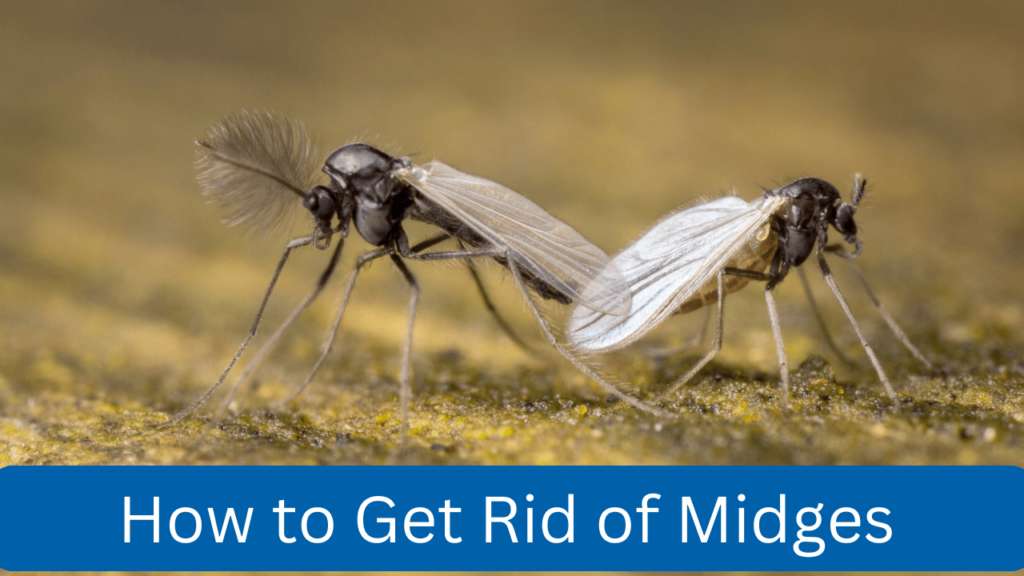Midges are tiny flying insects that are common in Ireland, especially in rural and wet areas. These insects are notorious for their bites, which can be itchy and irritating. If you live in or plan to visit Ireland, especially during the summer months, you might wonder how to deal with these pesky creatures. In this guide, we’ll explore effective ways to get rid of midges and prevent their bites.
What Are Midges?
Midges are small flies from the Culicoides family. They are most active in warm, damp conditions and are particularly annoying near lakes, bogs, and wooded areas. Their bites can cause itchy red spots, which can be uncomfortable for days.
When Are Midges Most Active?
- Peak Season: May to September
- Peak Hours: Early morning and late evening (especially during calm weather)
Table: Common Midges Habitats in Ireland
| Location | Why It Attracts Midges |
|---|---|
| Lakes and rivers | High humidity and stagnant water |
| Boglands | Damp, wet environment |
| Forested areas | Shade and moisture |
| Coastal regions | Calm weather and tidal pools |
How to Get Rid of Midges
1. Prevent Midges From Entering Your Home
Keeping midges out of your living spaces is the first step in managing them.
- Install Window Screens
- Use fine mesh screens on windows and doors to block entry.
- Repair any holes in the screens promptly.
- Keep Lights Dim
- Midges are attracted to bright lights, especially in the evening. Use dimmer lights or close curtains at dusk.
- Seal Cracks
- Seal any gaps in windows, doors, or walls to prevent midges from sneaking in.
2. Use Midge Traps
Midge traps can effectively reduce their population.
- UV Light Traps
- Attract midges with UV light and trap them.
- Place these traps in areas with high midge activity.
- CO₂ Traps
- Mimic human breath to attract and capture midges.
- These are more expensive but very effective.
3. Apply Insect Repellents
Repellents are one of the most effective ways to keep midges off your skin.
- DEET-based Repellents
- Highly effective against midges.
- Apply on exposed skin and reapply as needed.
- Natural Alternatives
- Citronella, eucalyptus oil, and lavender oil can repel midges.
4. Wear Protective Clothing
Reduce exposed skin to minimize bites.
- Long-sleeved Shirts and Pants
- Wear lightweight but full-coverage clothing in midge-prone areas.
- Head Nets
- Use a head net when walking in areas with heavy midge populations.
5. Control Midges Outdoors
If midges are a problem in your garden or yard, these tips can help.
- Use Fans
- Midges struggle to fly in windy conditions. Use fans to create air movement around patios or seating areas.
- Remove Standing Water
- Eliminate puddles, birdbaths, or stagnant water sources where midges breed.
- Plant Midge-repelling Plants
- Plants like lavender, marigolds, and citronella can repel midges naturally.
DIY Remedies for Midges
- Homemade Midge Spray
- Mix water, vinegar, and a few drops of citronella oil in a spray bottle.
- Spray it around windows, doors, and outdoor seating areas.
- Candle Traps
- Place a lit candle in a bowl of water with a few drops of dish soap.
- Midges are attracted to the light and will drown in the water.
How to Avoid Midge Bites
- Plan Outdoor Activities Wisely
- Avoid outdoor activities during peak midge hours (early morning and late evening).
- Use Nets or Canopies
- Use midge nets or screened canopies for outdoor events or picnics.
- Choose Campsites Carefully
- Stay away from bogs, lakes, and other wet areas when camping.
Table: Comparison of Insect Repellents
| Repellent Type | Effectiveness Against Midges | Advantages | Disadvantages |
|---|---|---|---|
| DEET-based Repellents | Very High | Long-lasting protection | Strong chemical smell |
| Citronella Oil | Moderate | Natural and eco-friendly | Needs frequent reapplication |
| Eucalyptus Oil | High | Pleasant smell, natural | Can cause skin irritation |
| UV Light Traps | High | Effective for large areas | Requires electricity |
| CO₂ Traps | Very High | Mimics human breath effectively | Expensive |
Common Myths About Midges
- Myth: Midges are only active during the day.
- Truth: Midges are more active during twilight hours.
- Myth: Midges do not bite through clothing.
- Truth: They can bite through thin fabrics.
- Myth: Midges only live in rural areas.
- Truth: While more common in rural areas, they can also be found in urban gardens.
What to Do If You Get Bitten
If you’ve been bitten by midges, here’s how to reduce itching and swelling:
- Wash the Area
- Use soap and warm water to clean the bite area.
- Apply Cold Compress
- A cold pack or damp cloth can reduce swelling and itching.
- Use Antihistamines
- Over-the-counter antihistamines can help with allergic reactions.
- Apply Anti-itch Creams
- Calamine lotion or hydrocortisone cream can provide relief.
Final Thoughts
Getting rid of midges in Ireland can be challenging, but with the right methods, you can significantly reduce their impact on your life. By combining preventative measures, repellents, and outdoor control methods, you can enjoy Ireland’s beautiful scenery without constant bites.
Always remember to plan your outdoor activities carefully and be prepared with the right tools to keep these pesky insects at bay!

Hi, I’m Tanvir, the founder and author of Explore Ireland Now. With a deep love for Ireland and its rich culture, history, and landscapes, I created this site to share everything that makes this beautiful country worth exploring. Whether you’re a local looking for hidden gems or a traveler planning your next adventure, I provide insightful guides, tips, and recommendations to help you experience Ireland to the fullest.
From stunning landscapes to vibrant cities and quaint villages, Ireland is full of wonders waiting to be discovered. Through my personal experiences and research, I aim to bring you the most up-to-date information and inspiration for your journey.
Thank you for visiting Explore Ireland Now—I hope my content helps you uncover all that this incredible country has to offer! If you have any questions or need travel advice, feel free to reach out.



